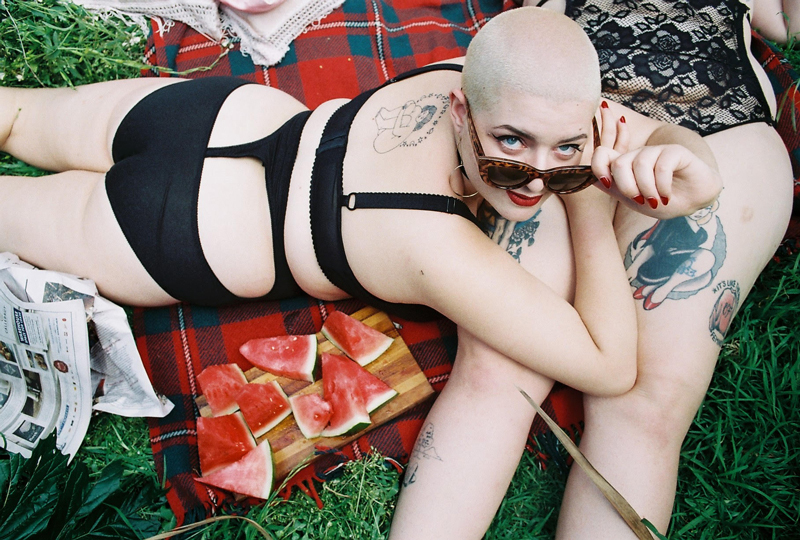In recent years, a lot of brands have been rethinking underwear and the people who buy it. The message is familiar: lingerie isn’t about the person taking it off, it’s about how an individual feels when they wear it. But for all the talk of body positivity and diversity, we still find ourselves asking how brands are active in their sentiments. After all, is a size 12 woman in a $200 bra really that radical? If we’re really that committed to celebrating “real women” why do so many brands refuse to make anything above a D-cup?
These, sometimes, empty sentiments weighed on Jarrah Benwell-Clarke and Bianca Cornale of JBC Lingerie. They wanted to do something real with underwear, so they bought a book. A book called How To Make Lingerie. And just like that a brand was born. Today they’re not only creating beautiful underwear, but presenting it in a way that can, in good conscience, be called real. They embrace different expressions of gender, as well as different kinds of bodies. And yes, they go up to an F-cup.
What’s your biggest frustration with the lingerie industry?
Jarrah: I suppose brands that are preaching body positivity but they don’t really back it up.
Bianca Cornale: And they might not have very inclusive sizing or the imagery might not be backed up by their work practices or how they sell. A lot of brands will have the imagery there but not the size options for curvier babes.
You have also been committed to different presentations of gender, which is refreshing— lingerie brands still tend to be super heteronormative.
Bianca: It’s important for us to represent gender diversity for a few reasons. Mostly because only accommodating one kind of woman, or one kind of person, is just not what we’re about. We try to continuously evolve who we shoot and who we cater to with each new thing we do — so representing gender diversity and having options for different kinds of babes was always such a logical step. No matter what your body looks like and whatever anatomy you have you should be able to have access to what you want.
How has embracing diversity changed the way you see lingerie?
Bianca: Working with the queer community helps change the more prevalent view of lingerie as being something exclusively for cis-women and their cis-het partner to enjoy. Lingerie can be for everyone, and ideally we’d be honoured if, in some small way, we can contribute to a babe being more comfortable in their true self, or finding something that helps with their expression of who they are. In that way again, it’s the idea of lingerie being for the wearer, whoever that might be, instead of for anyone else. I guess the automatic assumption is that lingerie is for women but moving from that and realising that it’s really about fit and how the lingerie fits on other people or people with other anatomies.

Talking about the extended role of underwear in people’s lives, how much do you consider the traditional connection between sex and lingerie when designing JBC?
Jarrah: It is a thought but that is more of the prevalent image of lingerie that’s been put out there in the past. It’s this male gaze and the thought that lingerie has to be for a partner, you don’t wear lingerie unless it’s for someone. We’re trying to advocate that lingerie can be for you whenever you’re feeling fucking sexy. We also make a point when we’re doing a shoot to avoid bed shoots, to try and focus on how they’re feeling in the underwear.
Bianca: But of course it’s going to look sexy, it’s babes in undies! We want it to look sexy, but it’s a different type of sexy. It doesn’t need to be for a partner, it doesn’t need to be for a sexy encounter.
Do you think people need to start to separate the connection between lingerie and sex?
Jarrah: I don’t think they need to separate it, they just need to see that lingerie is everyday, we wear it everyday as an everyday attire. It doesn’t necessarily need to be connected to sex. When I design the products I think of it in so many ways: there’s lingerie you wear to the bedroom or the daggy bra you wear it everyday because it’s so comfortable. Lingerie is worn for so many different reasons beyond sex. You can feel sexy without having sex or being desired by someone.
So to you, what is the role of nice underwear then?
Bianca: There is something really amazing about getting a new pair of undies, wearing them around a room and taking selfies. Even if you’re not going to send them to someone it’s like, ‘I look good! I’m gonna take some pics, I’m gonna feel fine’. In that way you can take lingerie away from the bedroom and it can just be for the wearer. It’s an interesting mode of self expression because nobody else may see it. It may just be private and it might just be for you, but it might make a difference in how you feel and in how you go about your day. That’s how it changes somebody, how it helps that person feel comfortable in their own skin.
Credits
Text Hilary Bourke
Photography Anna Cunningham.
Models Laura Vudè, Amari Winters and Manon Alfano
